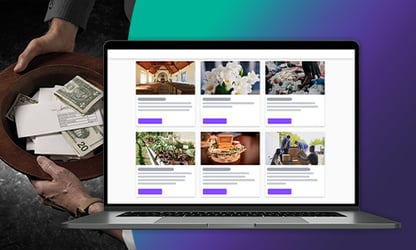
THE PATHWAY TO GENEROSITY PART 1
Does your congregation struggle to explain, model or implement a “culture of generosity?” Many find that all of the talk about generosity can leave members of their congregation exhausted or isolated when their personal experience doesn’t match the rhetoric or talking points about giving.
It is true that many of us aspire to live a life that reflects Christ, yet not everyone learned to give at an early age, has a wonderful history of growing up in a generous family or have had the experience of radical generosity in life altering personal stories that affirm their beliefs. How do we help congregations actually do the work of fostering authentic, generous church communities? If we embrace the truth about our complex structures, pews are filled with people who struggle with the topics we preach and teach about. Authentic faith, authentic relationship and authentic practices can breed generosity.
First, we must commit to authenticity. It requires us to get real and operate with a core set of (at times uncomfortable) values anchored in honesty. Sometimes people aren’t generous in our congregations because their needs are not met, their hearts have not been inspired, the examples have been limited and casting big vision has become rare. If we can’t address the hurts and concerns of people in a genuine way, it is impossible to foster generosity. What is intended for good can sometimes come across as begging for resources and support. Henri Nouwen proclaims in the Spirituality of Fundraising, that fundraising is the opposite of begging. We are called to proclaim vision and to invite people into the experience. Generosity requires relationship.
This past week I had the opportunity to present a plenary session at Pathways to Generosity: Signs of Hope, a conference sponsored by Ecumenical Stewardship Center, The Episcopal Network for Stewardship and the Center for Faith and Giving among others. The time in Dallas, Texas, was designed to help individuals explore their paths to faithful generosity and inspire new opportunities and experiences for diverse faith traditions and congregations across the country. I dedicated my time to sharing with faithful leaders the importance of being specific about how we tend to the path of generosity. Before we can address the tips and tools of effective giving systems, we are best served with lessons on how to live our faith in ways that attract, connect and build on the strengths of believers.
I have explained the concept of imperfect allies, championed the importance of shaping giving in children and addressed the importance of transparency. I have found people to be interested in the technical changes that are necessary for their stewardship practices, without understanding the significance of the adaptive changes. Ronald Heifetz and Marty Linsky define adaptive Leadership in ways that offer meaningful lessons to our communities. At its best, adaptive leadership helps congregations to re-evaluate the entire approach to giving, by understanding the role of generosity, money and resources from a broader vantage point. There is something critically important about separating generosity from financial giving alone. If we are to tend to the path of generosity, we must both see the role systems differently and learn to talk about the hard topics; including but not limited to money.
In the early moments of the plenary session, I shared reflections prompted by Suzanne Shanahan, Director of the Kenan Institute of Ethics, who has inspired many to rethink generosity to include the gift of giving the benefit of the doubt. As people of faith, there is a temptation to recast critical money conversations with industry code words, “culture of generosity, stewardship, philanthropy.” Yet, it is difficult to have a conversation about resources if we are not first prompted to re-examine what it means to be in authentic relationship with one another. While we respond to examples of a generous God that has blessed us, we can oftentimes rob people of the grace, mercy and dignity that has led to our own personal transformation. Generosity requires building different muscles when we are asked to intentionally think the best of those who disappoint and frustrate us; we are called to give to others the benefit of the doubt.
Philanthropy simply means love of humankind. Many within our pew don’t see themselves as philanthropists or benefactors, because the images and messages they have internalized cast others as having the resources and capacity to make a difference. In reality, Christ calls on each and every one of us to use our gifts and abilities to bless others. A culture of generosity is more about how we grow in relationship and treat one another, than any tangible gift or resource. As we’ve discussed the concept of a culture of generosity within the Ph.D. Program in African American Preaching and Sacred Rhetoric at Christian Theological Seminary, we’ve expressed it in this way: To shape a culture of generosity is to cast a vision of generously giving and graciously receiving so great in scope and spirit that all may thrive in an environment where the essence of everyone matters. A culture of generosity is an environment where relationship, connection, and transformation are critical to the how and why of operations.
Over the next few months, I will explore some of the building blocks that can foster culture of generosity:
- Spiritual Practice. Spiritual disciplines are activities undertaken for the purpose of inducing spiritual experiences. Generosity is a discipline and is anchored in response to the generosity we have witnessed and received. For people of faith, this core value is directly tied to beliefs about God and a theology of giving. In worship, the sacred practices, including giving, are essential rituals of faith that must be both recognized and celebrated.
- Radical hospitality. A spirit of welcome requires that everyone in our midst take responsibility for how we greet, engage, and follow up with guests — in how we welcome visitors, care for the sick and shut in, and the way that we attend to the needs of those in the margins. Gratitude and warmth are signature practices not to be delegated to clergy or a ministry leader. We are the hands and feet of Christ in the lives of others.
- Re-Think Generosity. Over my lifetime many of my mentors have taken a chance on me, offering access to unparalleled opportunities and experiences. Bill Enright, founding director of Lake Institute on Faith and Giving, welcomed my unique skill set into the shaping of workshops and trainings across the country. Within our congregations there are countless ways that sage leaders can build bridges to new opportunities and intentionally share the gifts and talents of church members.
- Cast a compelling case. Gone are the days when the development of an effective case statement are enough to lead the actions of grant writers, stewardship committees and fundraisers. The reality is – Money follows Mission, it always has and it always will. As a church, we should be talking more about how we understand our purpose, calling and mission. What is God requiring of us personally? What is God requiring of our congregations?
- Learn your Giving Story. One way we explore generosity is by understanding how God has been visible in our lives. Not everyone learned generosity at the hand or heel of a generous parent or grandparent, not everyone has a story of an amazing church with Sunday School, Bible Study, Vacation Bible School, Good Fiscal Management, Small Group, life altering scholarships, mission, outreach and evangelism excitement. For those with that experience, we have something to learn and something to teach from those rich experiences. We also must make room for those who have a story that is very different from our own.
At the conference, a woman quietly walked up to me after my first workshop and shared that her family of origin was not generous. She had been taught generosity at her church and she celebrated that her life had forever been changed by the lessons she had learned. Each week the sermon has the potential to interrupt life as usual and cause people to approach their faith in a new way.
We can’t teach and model what we do not understand. Well-informed believers and donors are more likely to give again. Whether or not they give now, every stakeholder needs to be reminded of the lasting impact of ministry and the why behind what we do.
Seeking a path to generosity? Be certain that you are able to articulate:
- Why do we exist?
- Why does it matter?
- What do we aspire to do in the world?
- What we aspire to accomplish in the world?
- How will the world be different when we fulfill God’s calling?
The sheer inability to share what God has asked of us compromises more than generosity. Lack of mission focus compromises the call to evangelism and limits our ability to share God’s transformation at work in our lives. Generosity begins when we refocus our attention on what matters most – our relationship to God, our call to mission and the ability to impact the lives of one another.
THE PATHWAY TO GENEROSITY PART 2

The qualities of being kind and generous can be taken for granted if we are not cautious. Many people replace the necessary roles of stewardship, fundraising and financial management with the term “generosity” as a catch-all phrase to encompass every aspect of dealing with resources in a faith-based context. When we overuse words and terms, however, the special nature and quality of the word can be lost.
I started an article series about the pathway to generosity following a spring conference where I was asked to talk about how we tend to that path of generosity. Excitement revisits me every time I think about the required effort, intentional actions, and urgency that is inherent in tending to generosity. If we want to have more generous congregations and members, our orientation toward generous must change.
The pathway of generosity is not a mechanism for getting something from someone, as in prompting more donations or securing more contributions to your mission or vision. Although that can happen, it is actually not the pursuit of generosity. That pursuit is one that asks, “how might I operate in extreme kindness, with an unselfish attitude or posture, to bless someone else’s life because of God’s abundant love and provision for me?”
In the previous article, I shared the importance of:
1. Spiritual practice
2. Radical hospitality
3. Re-thinking generosity
4. Casting a compelling case
5. Learning your giving story
Each of those practices remains significant for creating a pathway to generosity. The Biblical text Acts 16:11-5 captures the other practices in an often-overlooked story of Lydia of Thyatira. If you are interested in creating a pathway toward generosity, you’ll find the principles of listening, lifelong connection, personal touch and communicating the mission illuminated with precision here.
Lydia of Thyatira is a powerful example of the essential practices of generosity.
Listening is an active art form and should reign as the most significant part of your engagement with others. In the Book of Acts, Paul was listening to God when he traveled to Macedonia, and Lydia was at the river’s edge praying with other women, in a posture of receiving, when Paul’s message was delivered.
In the Lukan narrative, Lydia doesn’t speak for herself, but what we learn about her story from listening and observing is powerful. Generous people and generous congregations listen to those who are around them and pay careful attention to both what is said and what is unsaid. We should do no less in our engagement with our supporters and stakeholders.
Lydia was the first European convert to Christ. Her story does not end with her receiving the Good News of Christ and Baptism, even though she encouraged her entire household to follow her actions. What we see in the Book of Acts is a model of lifelong connectivity. Her response to Baptism was an invitation to Paul and Silas to come to her home. She was a woman of means, a seller of purple cloth, yet she did not just lead a transactional or business life. Lydia recognized the demands of travelers on a journey and saw the needs of people in ministry. She helped to craft a legacy for the early church, Philippi, and her home of Thyatira.
The lesson we gain says that relationship and community matter. Generosity is not best experienced in one act or one exchange, but in life-long learning, leading, and loving one another.
Paul shows us the power of trusting in a vision.
If we examine the Book of Acts, we see the humanity of Paul. He was responsive to a vision that was given directly to him, illuminating a need in Macedonia. Although ministry doors had been closed and his journey took him to places he had not anticipated, we see the illumination of personal touch time and time again. The interaction with the vision was personal, the engagement with Lydia was personal, the opening of one’s home is indeed, personal. If we are to be generous, we must not only be in relationship, but we must also engage with people in direct, specific and tailored ways.
After Paul had seen the vision, we got ready at once to leave for Macedonia, concluding that God had called us to preach the gospel to them. - Acts 16:15
Paul responded to vision. Lydia listened and responded generously. Think about your philanthropy and giving habits – you will undoubtedly encounter vision.
What is your big dream for the world? What are the activities, goals, processes, and initiatives that will get you there? We are often quick to believe that people of faith should give more, do more, serve more, and provide more to the congregations and institutions with which they affiliate. But we can be guilty of using religious words and catch phrases that have lost meaning and failed to capture the heart and energy of those we solicit for support.
If we seek generosity, we can only do so by being generous. Cast your big mission and vision in layered and intentional ways that invite connection and support.
Keeping Sight of a Life Bigger than Ourselves
If we are not careful, we can lose sight of the Lydia’s of the world. While there are countless Biblical stories about giving, money and wealth; Lydia challenges us to reflect on our role of being prepared for the moment, seeking something bigger than ourselves, and being willing to invite others to experience what we have experienced. Verse 15 illuminates, “She was a worshiper of God. The Lord opened her heart to respond to Paul’s message.”
Even when the Lord is at work in our ministry and people of faith are actively seeking God, a powerful message about a powerful mission is still required. Generosity requires mission.
Are you eager to tend to the path of generosity? Let us be in a posture of listening, be committed for lifelong connection, honor people with a personalized touch and share the mission and message of powerful ministries, so that we can continually invest in the lives of one another.
Listen
Members, donors, and program alumni should have opportunities not just to give to our institutions but also to talk about what motivates them to be generous — their experiences, their motivations for generosity, their hopes for the future. Leadership, administrative staff, and development professions are called to listen and internalize those stories of impact.
Build Lifelong Connections
Every guest, church visitor, member, or new student in a seminary context, is a future supporter. Engaging with individuals for the long-term is essential. Cultivate those in your community to be lifelong conversation partners, and for those who share values, lifelong ambassadors. Generosity of spirit breeds individuals who will continue to learn and grow, and ultimately invest, as they find new avenues of expressing their beliefs in the church and the world.
Keep a Personal Touch
Make it easy for people to give in ways that make sense for them as individuals. Supporters give when they have a relationship with the congregation, program, school or the cause, and its leadership. Online and direct mail appeals, depending on the audience, have to be personal and effective on multiple platforms. Electronic giving is a wonderful tool – but is not the motivator for giving.
Communicate the Mission
A culture of generosity means that the congregation, institution or seminary is fulfilling its mission while communicating about that mission to all stakeholders. Well-informed donors are more likely to give again. And whether or not they give, visitors, givers, members and alumni alike need to be reminded of the lasting impact of the ministries we serve.
Our calling is found in God’s vision. Our mission is both to cast to a broad audience and to fulfill in partnership with one another. Look to examples like Lydia and Paul to remember not only why generosity is impactful for givers and receivers. Remember that laying the path to generosity can be as simple as listening and observing, and that it’s important to take innovative opportunities to make a transformative difference in this world.
How is your church paying a path to generosity?









